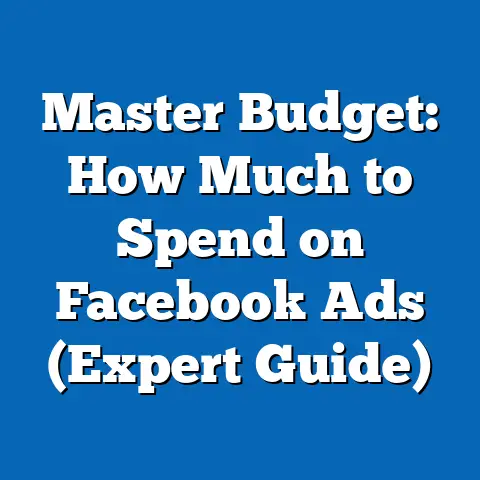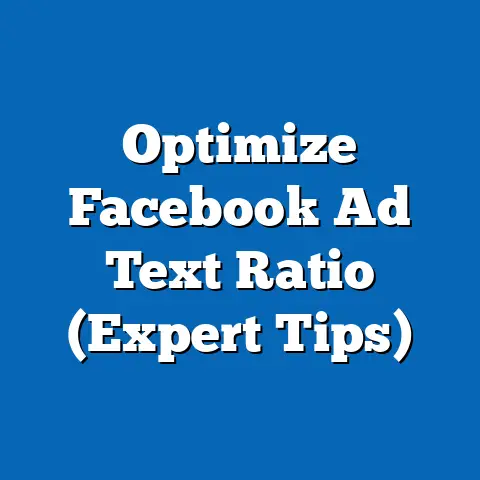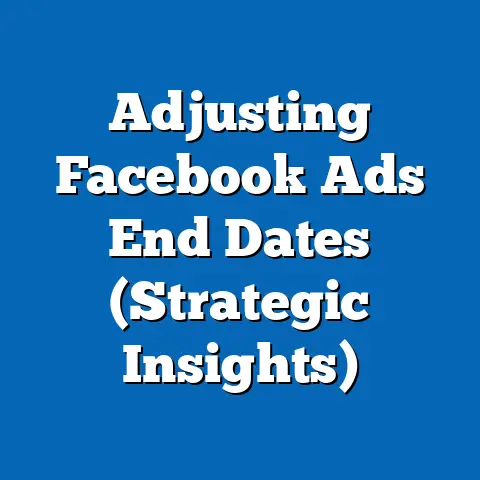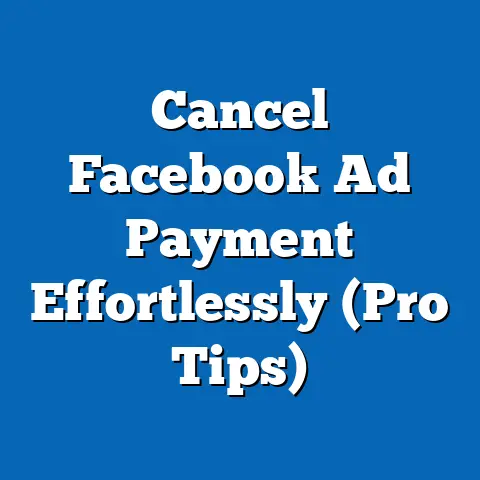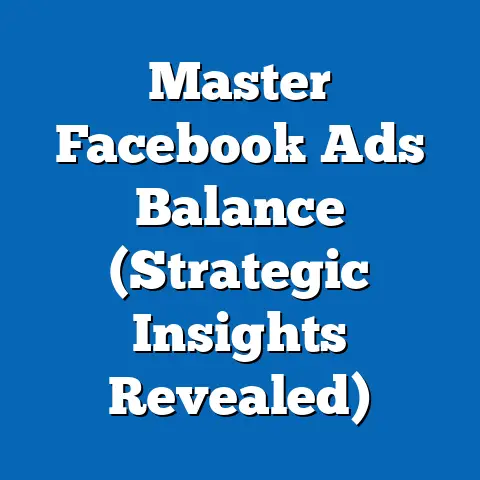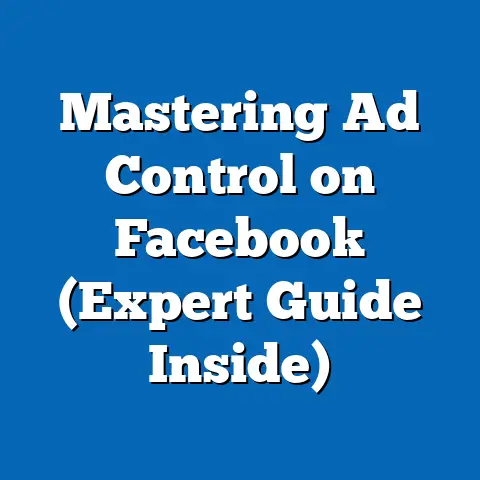Mastering Hiring Ads on Facebook (Proven Strategies)
The world of recruitment is evolving at a rapid pace. Gone are the days of solely relying on traditional job boards and word-of-mouth. Today, social media platforms like Facebook have become powerful tools for attracting top talent. In fact, studies show that over 79% of job seekers use social media in their job search, and Facebook is a key player in this arena.
I remember when I first started experimenting with Facebook ads for hiring. I was working with a small tech startup struggling to find qualified software engineers. We poured money into traditional job boards with little to no results. Frustrated, I decided to try a different approach and launched a targeted Facebook ad campaign. To my surprise, we received a flood of applications from highly skilled candidates within just a few weeks! We ended up hiring two exceptional engineers who are still with the company today. This experience taught me the immense potential of Facebook ads for recruitment.
Section 1: Understanding the Facebook Advertising Ecosystem
Before jumping into creating your first hiring ad, it’s essential to grasp the fundamentals of the Facebook advertising ecosystem. Facebook, now under the umbrella of Meta, offers a robust advertising platform with a vast reach and sophisticated targeting capabilities. Understanding how it works will lay the groundwork for your success.
How Facebook Ads Work
Facebook ads operate on an auction-based system. Advertisers bid for ad space, and Facebook determines which ads to show to users based on factors like bid amount, ad quality, and estimated action rates. This means your ad’s success hinges on how well it’s crafted and targeted.
- Ad Formats: Facebook offers a variety of ad formats, including image ads, video ads, carousel ads, and collection ads. Each format has its strengths and is suitable for different types of content and objectives. For hiring, video ads showcasing your company culture or carousel ads highlighting different job openings can be particularly effective.
- Targeting Options: One of Facebook’s greatest strengths is its advanced targeting options. You can target users based on demographics (age, location, gender), interests, behaviors, and even connections. For hiring, this allows you to precisely target candidates with specific skills, experience, and interests.
- Placement: Facebook allows you to choose where your ads appear, including the Facebook News Feed, Instagram Feed, Audience Network, and Messenger. Consider where your target audience is most active when selecting placements.
Facebook in the Recruitment Landscape
Facebook is no longer just a social networking platform; it’s a powerful recruitment tool. Here’s why:
- Vast User Base: With billions of active users, Facebook offers unparalleled reach. This means you can potentially reach a large pool of qualified candidates, even for niche roles.
- Passive Candidate Reach: Many potential candidates aren’t actively looking for jobs on traditional job boards. Facebook allows you to reach these passive candidates who might be open to new opportunities if the right offer comes along.
- Brand Building: Hiring ads on Facebook can also help build your employer brand. By showcasing your company culture, values, and employee benefits, you can attract candidates who align with your organization’s mission.
- Cost-Effectiveness: Compared to traditional recruitment methods like job boards or recruitment agencies, Facebook ads can be a more cost-effective way to reach a large pool of qualified candidates.
Organic Reach vs. Paid Ads for Hiring
While building an organic presence on Facebook is important, it’s not enough for effective recruitment. Organic reach has declined significantly over the years, meaning fewer people see your posts without paid promotion.
- Organic Reach: Refers to the number of people who see your posts without paid advertising. It’s primarily driven by your followers and their engagement with your content.
- Paid Ads: Allow you to reach a much wider audience and target specific demographics, interests, and behaviors. This is crucial for reaching the right candidates who might not be following your company page.
For hiring purposes, paid ads offer several advantages over organic reach:
- Targeted Reach: Reach candidates with specific skills, experience, and interests.
- Scalability: Easily scale your reach and visibility as needed.
- Measurable Results: Track key metrics like click-through rates, application rates, and cost-per-hire.
Takeaway: Understanding the Facebook advertising ecosystem and leveraging paid ads is crucial for effective recruitment. By utilizing the platform’s targeting capabilities and diverse ad formats, you can reach a wider pool of qualified candidates and build your employer brand.
Section 2: Defining Your Hiring Goals and Target Audience
Before launching any hiring ad campaign, it’s essential to define your goals and identify your target audience. This will ensure that your ads are relevant, effective, and reach the right people.
Defining Clear Hiring Goals
What do you hope to achieve with your Facebook hiring ads? Are you looking to fill a specific role, build a talent pipeline, or increase brand awareness among potential candidates? Defining your goals will guide your ad creation and targeting strategy.
- Specific Role: If you’re hiring for a specific role, clearly define the job title, responsibilities, required skills, and experience level. This will help you create targeted ads that attract candidates who meet your specific requirements.
- Talent Pipeline: Building a talent pipeline involves attracting candidates who may not be immediately available but could be a good fit for future openings. This can be achieved by creating ads that showcase your company culture and career opportunities.
- Brand Awareness: Increasing brand awareness among potential candidates can help you attract top talent in the long run. This can be done by creating ads that highlight your company’s values, mission, and employee benefits.
Creating a Candidate Persona
A candidate persona is a fictional representation of your ideal candidate. It’s based on research and data about your existing employees and the skills, experience, and attributes you’re looking for in new hires.
- Demographics: Include details like age, gender, location, education level, and family status.
- Professional Background: Include details like job title, industry, experience level, skills, and career goals.
- Interests and Hobbies: Include details about their interests, hobbies, and online behavior.
- Pain Points and Motivations: What are their biggest challenges and what motivates them in their career?
For example, if you’re hiring a software engineer, your candidate persona might look like this:
- Name: Alex
- Age: 28
- Location: San Francisco, CA
- Education: Bachelor’s degree in Computer Science
- Job Title: Software Engineer
- Experience: 3 years
- Skills: Java, Python, JavaScript, Agile methodologies
- Interests: Open-source projects, tech conferences, online coding communities
- Motivations: Opportunities for growth, challenging projects, collaborative environment
Segmenting Your Target Audience
Once you have a candidate persona, you can segment your target audience based on various factors to create more targeted ads.
- Location: Target candidates based on their geographic location. This is particularly important if you’re hiring for roles that require on-site presence.
- Interests: Target candidates based on their interests, hobbies, and online behavior. This can help you reach candidates who are passionate about your industry or company.
- Professional Background: Target candidates based on their job title, industry, experience level, and skills. This is crucial for reaching candidates who have the specific qualifications you’re looking for.
- Education: Target candidates based on their education level and field of study. This can help you reach candidates who have the necessary academic background for the role.
Takeaway: Defining your hiring goals and creating a detailed candidate persona are crucial for effective targeting. By segmenting your audience based on various factors, you can create more relevant and engaging ads that attract the right candidates.
Section 3: Crafting Compelling Ad Content
The content of your hiring ad is what will ultimately capture the attention of potential candidates. It needs to be clear, concise, and compelling, highlighting the key benefits of working for your company and the specific opportunities available.
Writing Effective Ad Copy
Your ad copy should be written with your target audience in mind. Use language that resonates with them and highlights the aspects of the job and your company that are most likely to appeal to them.
- Tone: Use a tone that is authentic and reflects your company culture. Are you a fun, casual company or a more formal, professional organization?
- Clarity: Be clear and concise in your messaging. Avoid jargon and use simple language that everyone can understand.
- Call-to-Action: Include a clear call-to-action that tells candidates what you want them to do next. Examples include “Apply Now,” “Learn More,” or “Visit Our Careers Page.”
- Highlight Benefits: Focus on the benefits of working for your company, such as competitive salary, excellent benefits, opportunities for growth, and a positive work environment.
- Address Pain Points: Acknowledge the challenges that candidates might be facing in their current roles and explain how your company can help them overcome those challenges.
The Significance of Visuals
Visuals are a crucial element of your hiring ads. They’re the first thing that catches the eye and can make a significant impact on whether or not someone clicks on your ad.
- Images: Use high-quality images that are relevant to the job and your company culture. Consider using images of your employees, your office space, or your company events.
- Videos: Videos can be even more effective than images. They allow you to showcase your company culture, provide a behind-the-scenes look at your workplace, and hear directly from your employees.
- Branding: Ensure that your visuals are consistent with your company’s branding. Use your company colors, fonts, and logo to create a cohesive and recognizable brand identity.
I once worked with a client who was struggling to attract candidates for a customer service role. Their initial ads used generic stock photos and lacked any personality. I suggested they create a short video featuring their current customer service team, showcasing their friendly and supportive work environment. The results were remarkable! The video resonated with potential candidates, and they saw a significant increase in applications.
Essential Information to Include
In addition to compelling visuals and engaging copy, your hiring ads should also include essential information about the job and your company.
- Job Title: Clearly state the job title so candidates know exactly what role you’re hiring for.
- Responsibilities: Briefly outline the key responsibilities of the role.
- Qualifications: List the essential qualifications and skills required for the job.
- Company Overview: Provide a brief overview of your company, its mission, and its values.
- Unique Selling Points: Highlight what makes your company a great place to work. This could include your company culture, employee benefits, opportunities for growth, or innovative projects.
Takeaway: Crafting compelling ad content is essential for attracting the right candidates. Use clear, concise, and engaging copy, high-quality visuals, and essential information about the job and your company.
Section 4: Setting Your Budget and Bidding Strategy
Setting the right budget and choosing the appropriate bidding strategy are crucial for maximizing the impact of your Facebook hiring ads. Without a well-defined budget and strategy, you risk overspending or not reaching enough qualified candidates.
Budgeting Options
Facebook offers two main budgeting options:
- Daily Budget: Sets a fixed amount you’re willing to spend each day. This is a good option if you want to control your daily spend and ensure that your ads run consistently.
- Lifetime Budget: Sets a total amount you’re willing to spend over the entire duration of your campaign. This is a good option if you have a specific budget in mind and want to ensure that you don’t exceed it.
When determining your budget, consider factors like:
- Target Audience Size: The larger your target audience, the more you’ll need to spend to reach them.
- Competition: The more competition there is for your target audience, the higher your bids will need to be.
- Hiring Urgency: If you need to fill a role quickly, you might be willing to spend more to reach candidates faster.
- Job Location: Costs can vary substantially depending on the location of your job. Major metropolitan areas are often more expensive for advertising.
Bidding Strategies
Facebook offers several bidding strategies, each with its own advantages and disadvantages:
- Cost Per Click (CPC): You pay each time someone clicks on your ad. This is a good option if you want to drive traffic to your website or landing page.
- Cost Per Impression (CPM): You pay for every 1,000 impressions your ad receives. This is a good option if you want to increase brand awareness.
- Cost Per Action (CPA): You pay for each specific action someone takes, such as submitting an application or visiting your careers page. This is the most targeted, but it requires careful tracking and setup.
- Value Optimization: Facebook uses its algorithm to find people who are most likely to take a valuable action, such as submitting an application. This requires some historical data for Facebook to learn from.
Choosing the right bidding strategy depends on your hiring goals and budget. If you’re focused on driving applications, CPA or Value Optimization might be the best option. If you’re focused on increasing brand awareness, CPM might be a better choice.
Optimizing Ad Spend
Optimizing your ad spend is crucial for maximizing your ROI. Here are some tips:
- Monitor Your Campaign: Regularly monitor your campaign performance and make adjustments as needed.
- A/B Test Your Ads: Test different ad copy, visuals, and targeting options to see what works best.
- Refine Your Targeting: Refine your targeting to reach the most qualified candidates.
- Adjust Your Bids: Adjust your bids based on performance. If your ads are performing well, you can increase your bids to reach more people. If they’re not performing well, you can decrease your bids to save money.
Takeaway: Setting the right budget and choosing the appropriate bidding strategy are crucial for maximizing the impact of your Facebook hiring ads. Monitor your campaign performance and make adjustments as needed to optimize your ad spend.
Section 5: Launching and Monitoring Your Hiring Ads
Once you’ve crafted compelling ad content and set your budget and bidding strategy, it’s time to launch your Facebook ad campaign and monitor its performance.
Launching Your Campaign
Here are the steps to launch a Facebook ad campaign:
- Go to Facebook Ads Manager: Access the Ads Manager through your Facebook business page.
- Create a New Campaign: Click the “Create” button to start a new campaign.
- Choose Your Campaign Objective: Select your campaign objective. For hiring ads, options like “Traffic,” “Lead Generation,” or “Conversions” are typically the most relevant.
- Define Your Target Audience: Define your target audience based on demographics, interests, behaviors, and connections.
- Set Your Budget and Schedule: Set your daily or lifetime budget and choose the start and end dates for your campaign.
- Choose Your Ad Placement: Choose where you want your ads to appear (e.g., Facebook News Feed, Instagram Feed, Audience Network).
- Create Your Ad: Create your ad using the ad copy, visuals, and call-to-action you’ve developed.
- Review and Publish: Review your campaign settings and publish your campaign.
Monitoring Ad Performance
Once your campaign is launched, it’s essential to monitor its performance using Facebook Ads Manager. Key metrics to track include:
- Impressions: The number of times your ad was shown to users.
- Reach: The number of unique users who saw your ad.
- Click-Through Rate (CTR): The percentage of users who clicked on your ad after seeing it.
- Cost Per Click (CPC): The amount you paid for each click on your ad.
- Conversions: The number of users who took a desired action, such as submitting an application or visiting your careers page.
- Cost Per Conversion (CPA): The amount you paid for each conversion.
By monitoring these metrics, you can identify areas where your campaign is performing well and areas where it needs improvement.
Data-Driven Adjustments
Based on your performance metrics, make data-driven adjustments to your campaign.
- Refine Your Targeting: If your ads are not reaching the right candidates, refine your targeting to reach a more qualified audience.
- Adjust Your Bids: If your ads are not getting enough impressions or clicks, increase your bids. If your ads are performing well but your cost per conversion is too high, decrease your bids.
- A/B Test Your Ads: Continuously A/B test different ad copy, visuals, and call-to-actions to see what resonates best with your target audience.
- Pause Underperforming Ads: If certain ads are consistently underperforming, pause them and focus on the ads that are driving the best results.
Takeaway: Launching and monitoring your hiring ads is crucial for maximizing their impact. By monitoring key metrics and making data-driven adjustments, you can optimize your campaign performance and attract the right candidates.
Section 6: Evaluating Success and Iterating on Your Strategy
After your hiring ad campaign has run its course, it’s essential to evaluate its success and iterate on your strategy for future campaigns. This involves analyzing your performance metrics, gathering feedback from applicants and employees, and staying updated on the latest trends and best practices.
Evaluating Campaign Success
How do you know if your hiring ad campaign was successful? Here are some metrics to consider:
- Number of Applications Received: How many applications did you receive as a result of your campaign?
- Quality of Applications: How qualified were the candidates who applied?
- Cost Per Application: How much did it cost you to receive each application?
- Number of Hires: How many candidates did you hire as a result of your campaign?
- Cost Per Hire: How much did it cost you to hire each candidate?
- Time to Fill: How long did it take you to fill the open position?
By analyzing these metrics, you can determine the overall effectiveness of your hiring ad campaign and identify areas where you can improve.
Gathering Feedback
In addition to analyzing your performance metrics, it’s also important to gather feedback from applicants and employees.
- Applicant Feedback: Ask applicants about their experience with your hiring process, including your Facebook ads. What did they like about the ads? What could be improved?
- Employee Feedback: Ask your employees about their experience working at your company. What do they value most about working for your organization? Use this feedback to highlight these aspects in your future hiring ads.
Continuous Improvement
The world of Facebook advertising is constantly evolving. New features are introduced, algorithms change, and best practices shift. It’s essential to stay updated on the latest trends and best practices to ensure that your hiring ads remain effective.
- Follow Industry Blogs and Publications: Stay informed about the latest trends and best practices in Facebook advertising and recruitment marketing.
- Attend Conferences and Webinars: Network with other professionals and learn from experts in the field.
- Experiment with New Features: Don’t be afraid to try out new features and ad formats that Facebook introduces.
- Continuously Test and Optimize: Continuously test different ad copy, visuals, and targeting options to see what works best for your target audience.
Takeaway: Evaluating the success of your hiring ad campaigns and iterating on your strategy is crucial for long-term success. By analyzing your performance metrics, gathering feedback, and staying updated on the latest trends and best practices, you can continuously improve your hiring ads and attract the best talent to your organization.
Conclusion
Mastering hiring ads on Facebook is an ongoing process that requires dedication, experimentation, and a willingness to adapt to change. By understanding the Facebook advertising ecosystem, defining your hiring goals and target audience, crafting compelling ad content, setting your budget and bidding strategy, launching and monitoring your campaigns, and evaluating your success, you can transform your recruitment process and build a high-performing team.
I urge you to take the strategies outlined in this article and put them into practice. Start small, experiment with different approaches, and continuously monitor your results. The world of Facebook advertising is dynamic, but with the right knowledge and approach, you can unlock its power to attract top talent and drive your company’s success. Now go out there and create some amazing hiring ads!

